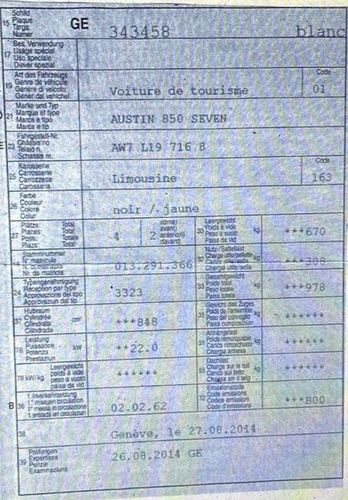Buyer's fee : 5% of the hammer price
Learn more about the auction process
 Suisse, Nyon
Suisse, NyonONLINE AUCTION FROM 03.04.2024 TO 13.04.24 AT 19H00
- Chassis number: AW7 L19 716 8
- 1st registration: 02.02.1962
No reserve price
This 1962 Austin Seven 850 Countryman is for sale at auction without reserve price. This means that the car will be sold to the highest bidder, regardless of the amount of the final bid.
Back to the roots of the Austin Mini.
We are pleased to offer for sale, without reserve price, this Austin Seven 850 Countryman. A unique opportunity for enthusiasts and collectors to acquire a rare and little-known vehicle.
The Austin Seven 850 is a beloved classic. Compact yet spacious, it offered the best of both worlds: the driveability of a Mini, with extra space for passengers and luggage. This one being a Countryman, with its "barn-door" rear doors, never goes unnoticed and evokes an era when simplicity met innovation. Under the hood, the 850cc 4-cylinder engine is true to the Mini spirit, reliable and robust.
This model on sale is one of the very first Austins with the 850cc engine. It's all the more rare and original in its Countryman version, with its extended styling and hinged doors! This version is best known in its "Woody" finish. In the "All Steel" finish, a Woody kit can be fitted.
You're probably wondering what the patterns on the bodywork are all about... It's a caning that was carried out by the first owner's uncle. This hand-crafted caning lends the car a unique charm due to its period authenticity.
History
This Austin was taken out of service around 2 years ago following an invalid technical inspection due to the presence of rust. It was driven regularly before that by its owner and then by his son in Geneva.
Vehicle condition
Unrestored, this car is a good opportunity to acquire a working 1962 Austin with some work to be done, or a restoration project for the more meticulous. The engine starts immediately and the car is mechanically flawless. A service is nevertheless required on the vehicle. For the enthusiast who wants a flawless car, cosmetic work is required. For those wishing to do the bare minimum, rust will have to be treated before the car can be presented for appraisal.
Exterior: The paint is peeling in some places, and there are a few bumps visible on the photos. Rust spots are also visible in some places. A complete repaint should be considered.
Interior: The seats were replaced a few years ago and are new. The car radio or speaker no longer seem to work. The headliner has a hole in the center. Some leather parts need to be revised.
Mechanical: It starts easily, and the engine runs smoothly. Servicing is due. The chassis is solid and in good condition, although there are some traces of rust, but it is not perforating.
This is an attractive opportunity to obtain a vehicle that is easy to work on, benefiting from cheap and extremely accessible parts.
- Mileage not guaranteed (5-digit odometer).
- This vehicle is sold as is, without warranty.
- Our auction system incorporates an Anti-Sniping feature: if a bid is placed during the last 5 minutes of the auction, the counter is automatically extended by 5 minutes, giving all participants a fair chance of winning the vehicle.
History of the model
Launched in 1959, the Mini, an economical small car developed by the British Motor Corporation (BMC) and designed by Alec Issigonis, quickly became an iconic British symbol. It featured a transverse front-mounted engine and front-wheel drive, optimizing space in a vehicle just 3.05 m long.
Originally, two models were launched in 1959: one by Morris under the name Minor and one by Austin under the name Seven. They differed only in a few minor aesthetic details. These models were later further developed in different versions under two different brands, which nevertheless belonged to the same group (Austin and Morris). Commercial, sports and luxury versions, including the Countryman estate, enriched the range.
Alec Issigonis opted for a radical approach and chose wheels measuring just 10 inches. He rejected conventional suspension in favor of an invention by his friend Alex Moulton and used rubber cones as the suspension system.
The Mini continued to evolve but remained true to its original spirit until the end of its production in 1983, cementing its status as an icon of British popular culture (before being relaunched a few years later with 'newer' versions).
We can be reached by email [email protected] or by phone +41 79 516 03 44.



